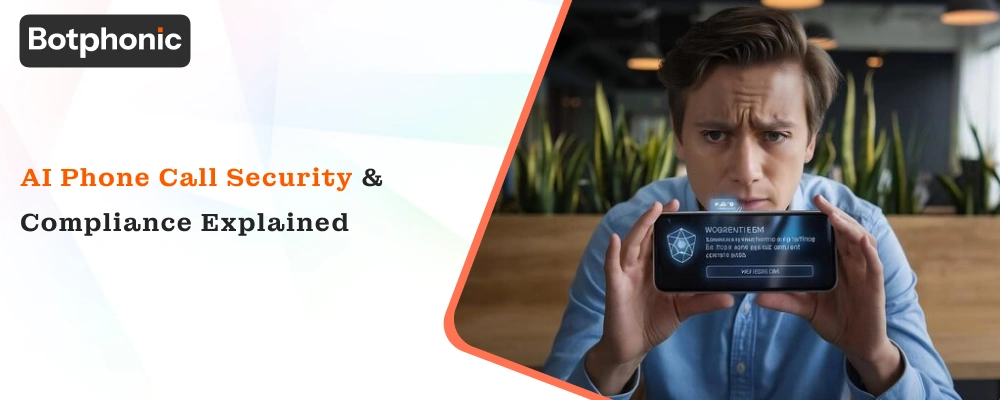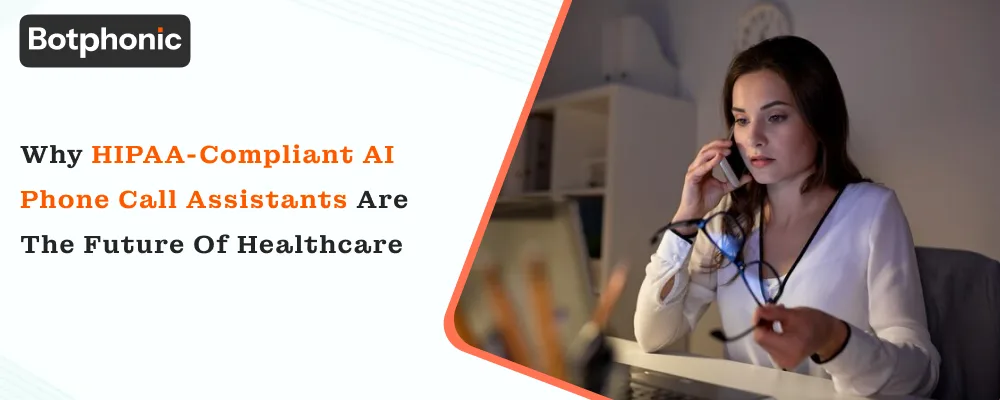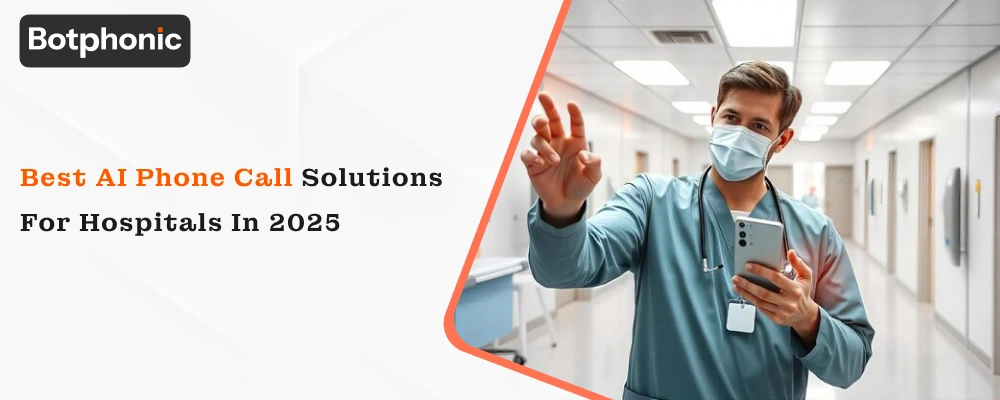
Summarize Content With:
Summary
This blog examines the necessity of AI-powered call solutions in hospitals, key features to consider in 2025, and how to select and implement the most effective AI phone call solution for hospitals.
Key Takeaways
- The first and foremost AI-based call system will effectively limit the number of calls that go unanswered, and patients will have a better experience with the hospital’s care service.
- Along with these, safety measures in healthcare, EMR integration, multilingual assistance, and continuous service are among the most crucial hospital features.
- We compare vendor solutions and then show you how to evaluate them for your hospital environment.
- We demonstrate how Botphonic might be a good fit as a future-ready hospital phone call automation solution.
Introduction
Imagine a person in need of medical care calling the main hospital number in the middle of the night to inquire about their upcoming MRI. While the phone keeps ringing, a virtual assistant, functioning on AI phone call, who already knows everything about the patient, operates the call; hence, no human is needed.
The assistant can even reschedule the appointment and update the system. That situation is not far off in the future. In 2025, hospitals that utilise smart voice-call automation experience fewer unanswered calls and improved patient flow, and staff are less overloaded than before. This blog will describe such a technological voice call advance system as well as how Botphonic might facilitate its smooth deployment in your hospital.
Why hospitals need AI phone-call solutions now?
High call volumes often put hospitals in a difficult situation, with peak times or overnight periods being the most challenging. Traditional call centres are generally inefficient for people waiting on the line, as they often result in lost calls or incorrect information from the employee.
Additionally, patient demands continue to increase. Regardless of whether it is a call for scheduling, billing, symptom reporting, or receiving test results, patients thoroughly expect rapid and precise service in return. Researchers posit that voice AI assistants for hospitals should possess the qualities of always being available to answer calls, recognising multi-intent queries, and transferring calls to humans when necessary.
Adhering to healthcare regulations and ensuring the security of patient data add an additional layer of complexity. Basically, a hospital AI phone call assistant should be a system that is risk-free, compliant with the rules, and smoothly fits into the existing medical workflows.
Compliance with healthcare laws and the security of patient data add another dimension to the problem: any hospital phone call solution must be trustworthy, conform to regulations, and seamlessly integrate into medical workflows. When set up correctly, a hospital voice-AI platform not only makes patients happy but also serves as an efficiency driver and cost-cutter.
What defines the “best AI phone call solution for hospitals” in 2025?
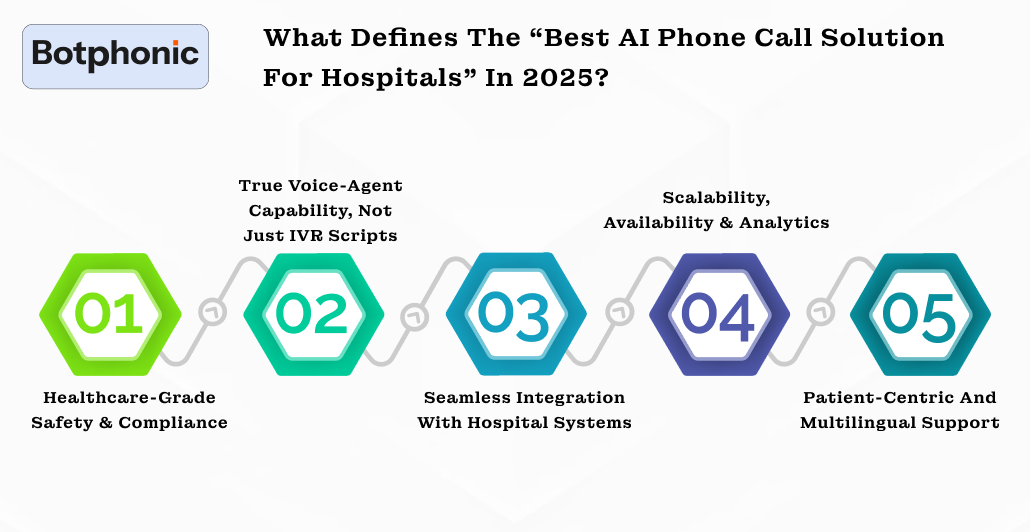
The year 2025 marks a turning point for AI that goes beyond simply integrating traditional hospital phone call automation with generic business processes. Here are the essentials:
1. Healthcare-grade safety & compliance
An AI call assistant sanctioned for hospital use must limit exposure to safety threats: no single person can receive medical advice outside of the perimeter. It should become more and more humanlike through the right channels and even maintain a log of the interaction. Citing an example from one field guide, “Nothing scary; anything clinical goes straight to the right human.”
Please be reminded that HIPAA (or its local equivalent), encryption, audit logs, and integration with your clinical risk frameworks are some of the key features your solution should support.
2. True voice-agent capability, not just IVR scripts
An AI phone agent of today does not simply present a menu to choose from. It also recognises everyday speech, understands multiple intents (“Change my Echo appointment and inquire about my report”), waits for a reply in the caller’s language, and completes the task correctly.
3. Seamless integration with hospital systems
The perfect solution connects with your EMR, PMS, scheduling system, telephone system, and CRM. A healthcare voice AI platform, for example, claims to “automate phone calls to patients, payors, and providers” and maintain high-level integrations through it.
4. Scalability, availability & analytics
Hospitals demand the service to be available 24 hours a day, 7 days a week, 365 days a year, with very high availability and the ability to cope with the peak seasons, as well as the recording of the call success, completion, accuracy of routing, and patient satisfaction, all of which require the use of analytics.
5. Patient-centric and multilingual support
Hospitals are places that cater to a diverse range of individuals. The AI must be able to detect different accents, understand various languages, and converse like a human, among other capabilities, and when necessary, seamlessly transition the conversation to human agents. The field guide explicitly states: “multi-intent and multilingual: make it feel natural.”
Implementation Roadmap: Steps for AI phone call solutions in hospitals
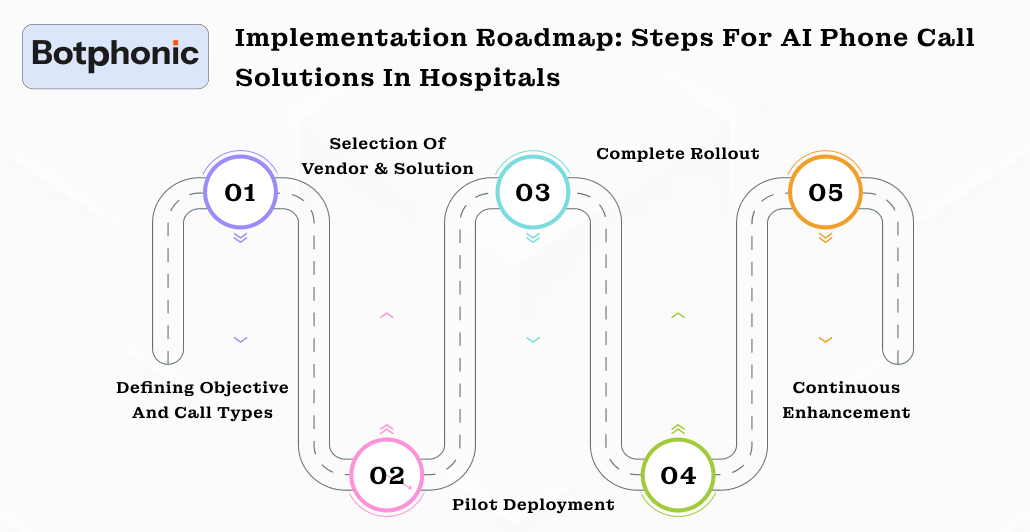
Implementing an AI system for phone calls in a hospital needs a step-by-step plan. The following points will help to secure a smooth launch:
1. Defining Objective and Call Types
Analyzing existing call flows (inbound and outbound) should be your first step. Be it appointments, inquiries, test results, or billing, classify your inbound calls and reminders or follow-ups for outbound calls. Set accurate KPIs: reduction in missed calls, decrease in hold time, solution offered in the first call, and patient satisfaction.
2. Selection of Vendor & Solution
Utilize the checklist provided in Section 2, as well as compare different vendors that consider Botphonic. Compare demos, request recent hospital use cases, verify language and accent support, and determine if integration with your systems is feasible.
3. Pilot Deployment
At first, deploy the solution in one hospital department only (e.g., radiology appointment scheduling or billing inquiries). Monitor the following metrics: call answer rate, improvement, staff feedback, and patient feedback, using Table 2 as your reference point.
4. Complete Rollout
As soon as the pilot project is the one, start moving into different departments. You should always have monitoring, training, updates, and support available in various languages. Provide an analytics dashboard for management.
5. Continuous enhancement
Utilise analytics to smooth out the flows, to attract the light of understanding on the interactions with AI, to conduct trials on the inclusion of new languages, and to perform ROI assessments every quarter. Keep an eye on the savings, the efficiency of the workers and the happiness of the patients.
Why Botphonic is the go-to choice for hospitals in 2025
- Botphonic provides customised phone-call automation for hospitals: appointment scheduling, patient follow-up calls, test-report reminders, billing inquiries, and triage routing.
- You highlight multilingual capabilities and Indian + global hospital support as main factors essential to consider India’s massive and varied patient base.
- Botphonic integrates with hospital systems (EMR/PMS scheduling) to ensure a smooth workflow, with no calls left unattended and no manual handoffs.
- Botphonic adheres to rules and safety measures (including HIPAA or its equivalent, audit logs, and patient data handling).
- Botphonic comes with cost-efficient deployment, saves calls that are not made because you are busy, reduces staff workload, and increases patient satisfaction.
Common pitfalls & how hospitals can avoid them
Hospitals face common issues when they put voice-AI into operation. The common mistakes and the solutions to them are given below:
- Over-promising full automation on day one. AI needs to start from simple, well-defined flows. The result, if everything is automated immediately, is failure at the highest risk. Tip: Start small and scale.
- Ignoring integration complexity. If the AI is unable to interact with the scheduling system or EMR, you will have calls that lead nowhere. Tip: Confirm technical compatibility in advance to avoid any issues.
- Unclear escalation/handoff rules. If callers become trapped in loops, patient anger escalates. Tip: Determine escalation reasoning and check it thoroughly.
- Lack of multilingual or cultural adaptation. In highly diverse environments (like India) accents/languages are very important. Tip Test the voice agent with local dialects and languages.
- Not measuring. Without baseline metrics and continuous analytics, it will be difficult to prove the value.
Pharmaceuticals still suffer because patients are unable to speak to anyone?
With Botphonic, your hospital can handle patient calls at any time instantly during the whole day without hold music and with no frustration.
Try It Now!Conclusion
Choosing the best AI phone call solution for hospitals is about improving care, not just technology.
With the right platform, you can significantly reduce the number of missed calls, alleviate staff from direct interactions, enhance patient satisfaction, and ultimately achieve a notable return on your investment.
While you are evaluating AI phone call assistants that are ready for 2025 and AI call assistant platforms, make safety, integration, multilingual support, scalability, and analytics your primary concerns. Botphonic is the one who is prepared to be your partner for the whole journey.
When assessing solutions from 2025 and later, ensure that healthcare-grade safety, integration, multilingual support, scalability, and data-driven improvement are prioritised areas. And when you are ready for the next move, Botphonic will be there as your partner.
